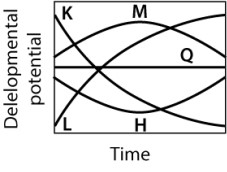Course
Anatomy & Physiology
Study Pack
Set 20 Genes And Development
Question 1
(Multiple Choice)
Free
Cellular differentiation progressively restricts cell fate because the unexpressed genes in the cell:
A)become more densely packed with nucleosomes.
B)accumulate point mutations.
C)accumulate deletions.
D)accumulate both point mutations and deletions.
E)undergo irreversible repression.
Answer
Question 2
(Multiple Choice)
Free
If one isolated cells at random from an organism at different times in its development and measured developmental potential as the average number of distinct cell types that the cells could differentiate into, which of the curves shown here would MOST likely result? 

A)curve M
B)curve H
C)curve K
D)curve L
E)curve Q
Answer
Question 3
(Essay)
Free
Many valuable horticultural varieties of plants, including roses, rhododendrons, junipers, geraniums, and so on, are commonly propagated by inducing roots to form on cuttings taken from branch tips. This method involves cutting a few inches from the tip of a branch and inserting the cut end into moist sand or other substrate. Under the right conditions, roots may form from the cut end, giving a new plant generated from the stem cutting. In what way could this phenomenon be used to argue for or against the "genome reduction" hypothesis for cell differentiation?
Answer
In order to produce roots, the branch cu...
View full Answer